Who Really Owns and Manages the Largest Apartment Portfolios in the U.S.

The U.S. apartment market is dominated by a few key players who own and manage a significant portion of the nation's rental properties. Here's what you need to know:
- Top Owners and Managers: The NMHC 50 owners control 11% of U.S. apartments, while the NMHC 50 managers oversee 21%.
- Largest Companies:
- Greystar leads with 946,742 units managed and 122,545 units owned.
- Other major players include MAA, Morgan Properties, Nuveen Real Estate, and Equity Residential.
- Ownership vs. Management:
- Owners handle investments, set rental prices, and bear financial risks.
- Managers focus on daily operations like maintenance and resident relations.
- Technology's Role: 90.2% of property managers use accounting software, and 81% have adopted payment systems for efficiency.
- Centralization Trends: Over 50% of large management firms centralize operations to standardize processes and improve efficiency.
| Category | Market Share | Leading Company | Units |
|---|---|---|---|
| Top Owners | 11% | Greystar | 122,545 |
| Top Managers | 21% | Greystar | 946,742 |
This article breaks down the strategies, innovations, and trends shaping the multifamily housing market in 2025, with a focus on the largest players and their evolving roles.
Lack of new construction and corporate landlords contributing to skyrocketing rent
Overview of Major Apartment Companies
The U.S. apartment industry is shaped by a handful of leading companies that dominate both ownership and management. Below is a breakdown of some of the top players and their portfolios:
| Company | Units Owned | Units Managed | Primary Focus |
|---|---|---|---|
| Greystar | 122,545 | 946,742 | Both |
| MAA | 102,348 | N/A | Owner |
| Morgan Properties | 96,727 | N/A | Owner |
| Asset Living | N/A | 288,665 | Manager |
| Willow Bridge Property Company | N/A | 220,676 | Manager |
These companies are known for their massive portfolios, which have driven changes in how operations are managed. Standardizing processes across such large holdings has become essential for maintaining efficiency and consistency.
This shift toward centralized operations is a growing trend. Marlee Murdock, Director of Operations and Transitions at Western Wealth Capital, sheds light on this approach:
"I've been working in property management for many years, and when we started to look seriously at centralization, we looked at all of the buckets of activity: Leasing, maintenance and admin. Admin was the biggest pain point for us - in a 40-property portfolio, 40 individuals are potentially doing things a little bit differently. We found that even if there are small inconsistencies in standard tasks, we're leaving money on the table." [3]
Centralizing administrative functions has become a key strategy for many large management companies - over 50% of them have adopted this approach [3]. By doing so, they ensure uniformity in operations while boosting overall efficiency.
Despite the focus on operational efficiency, maintaining a personal touch remains a priority. JC Castillo, founder of Velo Residential, highlights the importance of human connections in property management:
"We found that the personal connections our teams make onsite have a greater influence on the multifamily communities we manage" [3]
This balance - between leveraging scale for streamlined operations and fostering meaningful relationships with residents - defines the evolution of large-scale portfolio management today. These companies are increasingly using their size to implement advanced systems, all while prioritizing property performance and resident satisfaction.
1. Greystar

Greystar has firmly established itself as a leader in apartment ownership and management throughout the United States. By 2025, the company managed an impressive 946,000 units - an increase of 130,000 units compared to the previous year. Its owned portfolio surpassed 122,000 units, significantly ahead of MAA's 102,000 units [4][2].
What sets Greystar apart is its integrated approach, combining ownership, development, and management into a seamless operation. This strategy has driven its growth, with $79 billion in assets under management and operations spanning 211 markets through 63 offices [5][6].
| Portfolio Metrics (2025) | Numbers |
|---|---|
| Units Managed | 946,742 |
| Units Owned | 122,545 |
| Global Development Assets | $36+ billion |
| Markets Served | 211 |
| Team Members | 27,500+ |
These numbers highlight how Greystar's operational model fuels its success. A key element of this model is its innovative "pod structure", which blends a strong regional focus with centralized consistency. Melody Reid, Managing Director of Property Systems Engagement, explains:
"Our pods are really region-centric and sometimes client-centric. Even if someone isn't sitting in a specific market, they're trained and specialized in it. In today's regulatory environment, and with clients who have dynamic needs, we have to be able to flex - but without losing the consistency that centralization provides. Our model ensures both." [8]
Greystar's commitment to forward-thinking strategies is echoed by its Founder, Chairman, and CEO, Bob Faith:
"We remain focused on smart, sustainable growth and we are excited about what the future holds." [7]
The company has also leaned into technology to refine its operations. Through "The Greystar Advantage", it has standardized best practices and adopted a data-driven approach. This innovation helped cut year-over-year delinquency rates by 119 basis points, thanks to an AI-powered notification partnership with Pacific Urban Investors [8][9].
Expanding its portfolio further, Greystar entered the Built-to-Rent market. In 2025, the company began construction on the Summerwell Sunterra development in Katy, Texas. This project features 156 homes packed with amenities, including a Crystal Lagoon, clubhouse, fitness and event lawns, a pool, lazy river, playground, and tennis courts [10].
2. MAA (Mid-America Apartment Communities)
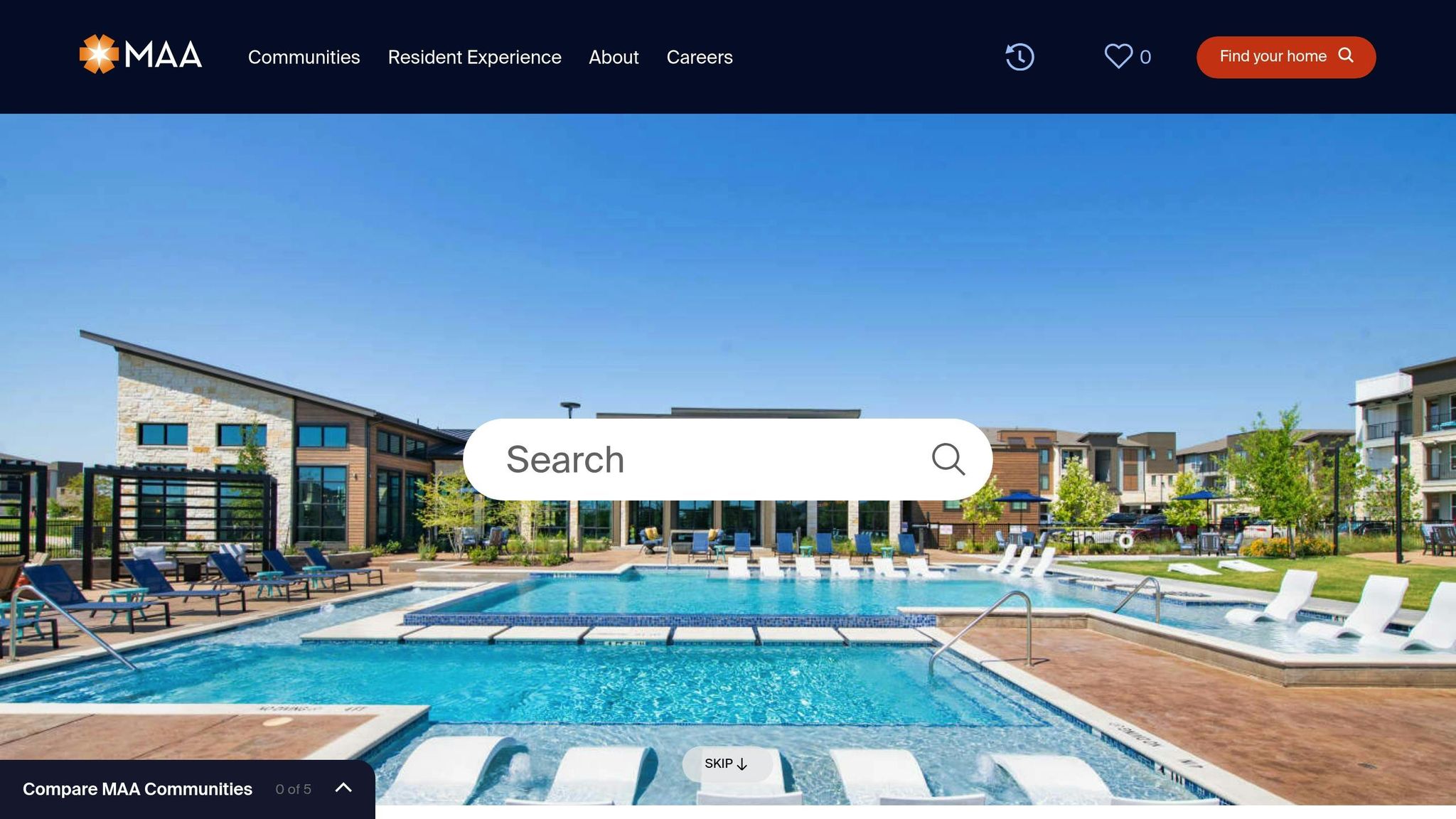
Building on the operational strategies seen with Greystar, MAA has carved out a reputation for steady portfolio expansion and solid financial performance.
By 2023, MAA owned 100,894 apartment units. This number climbed to 104,587 by the end of 2024, spanning 16 states and Washington, D.C. [11][12]. As a REIT primarily focused on the Sunbelt region, MAA's ownership is heavily weighted toward institutional investors (95.78%), with retail investors holding 4.00% and individual insiders accounting for just 0.22% [13].
Here’s a snapshot of MAA’s 2024 financials:
- Revenue: $2.19 billion
- Net Income: $527.54 million
- Core FFO: $7.77 per share
- Portfolio Occupancy Rate: 95.6%
[12][14][15]
Most of MAA's revenue - 94% - comes from rental income, while the remaining 6% is derived from other property-related services [12].
MAA’s portfolio includes a mix of Class A and Class B apartment communities, catering to residents across a range of income levels. This diverse approach strengthens its position in the multifamily housing market.
3. Morgan Properties
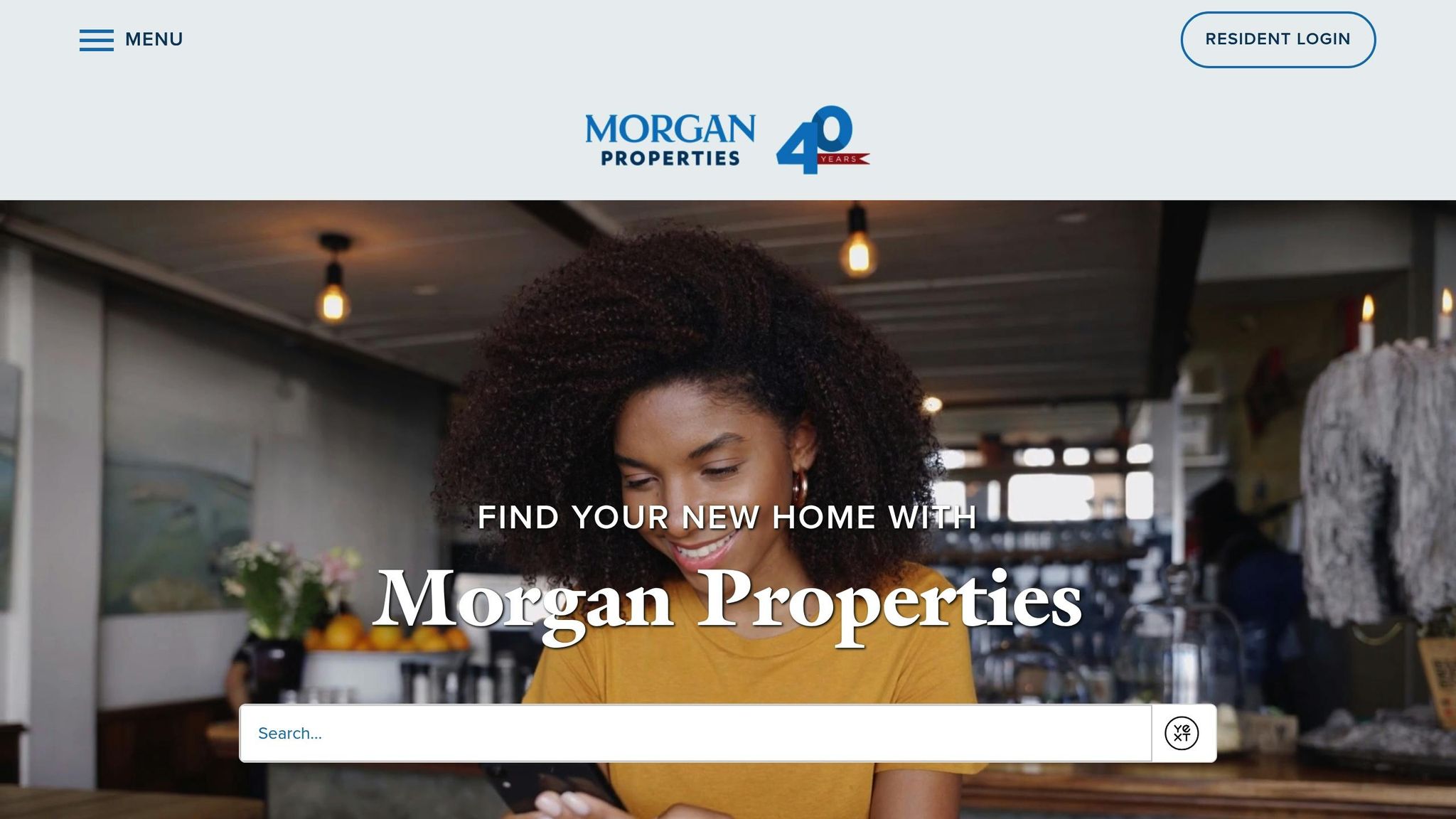
Morgan Properties holds the title of the largest private owner of multifamily communities in the United States, managing a portfolio of over 100,000 units spread across 360 communities in 22 states [18]. Impressively, the company has more than doubled its portfolio size in just six years.
As of April 2025, Morgan Properties continues to strengthen its market presence through strategic acquisitions. One notable example is the recent $501 million purchase of 3,054 units across 11 properties in eight Midwest states from Trilogy Real Estate Group [16][18]. This acquisition reflects the company’s commitment to a well-rounded and diversified investment strategy.
The company’s investment portfolio includes:
- Multifamily common equity
- Commercial mortgage-backed B-Piece securities
- Preferred equity
- Whole loans
Since 2017, Morgan Properties has acquired seven additional Freddie Mac K-Series B-pieces, bringing its total to 47. These investments represent approximately $43.8 billion in unpaid principal balance across 1,915 underlying loans [17].
"Surpassing 100,000 units is a defining moment and a testament to the hard work and dedication of our entire organization, who have helped shape Morgan Properties into a best-in-class multifamily owner and operator", said Jonathan Morgan and Jason Morgan, Co-Presidents of Morgan Properties [18].
In addition to acquisitions, Morgan Properties focuses on adding value through property management initiatives, such as:
- Interior renovations
- Enhanced on-site amenities
- Smart home technology integration
- Energy efficiency improvements
For instance, a $4 million renovation of Astoria Park Apartments includes unit upgrades and expanded amenities [19].
The company’s workforce has also seen significant growth, expanding by 70% over the past four years to more than 470 employees [17]. Morgan Properties operates nationwide from its corporate headquarters in Conshohocken, Pennsylvania, and an additional office in Rochester, New York [18].
4. Nuveen Real Estate
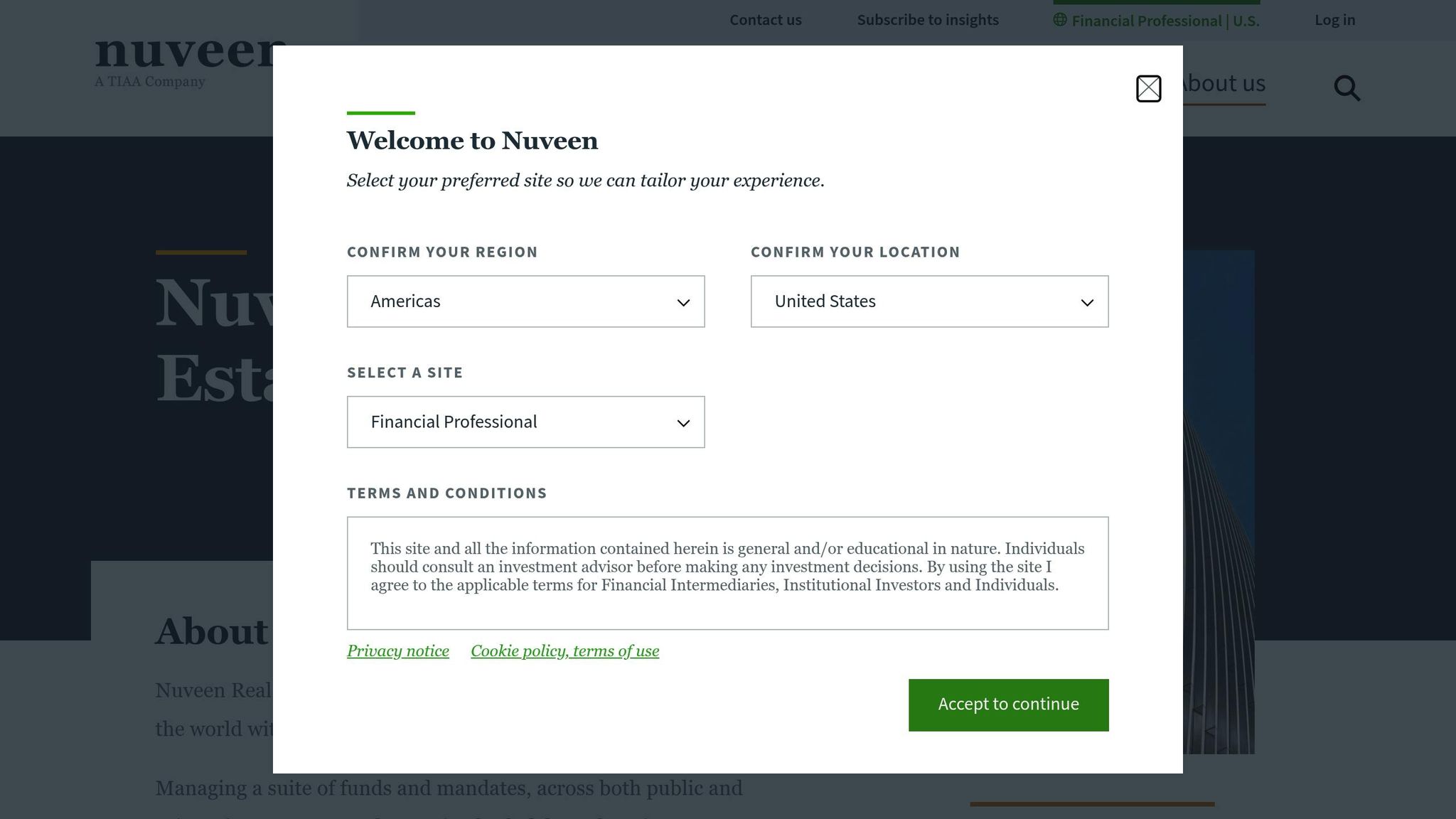
Nuveen Real Estate has steadily expanded its portfolio, managing a staggering $147 billion in assets, including 95,391 apartment units valued at $25.915 billion. This achievement positions them as the third-largest multifamily property owner in the U.S. [20][22].
The company’s portfolio has seen notable growth, increasing from 73,374 units in 2023 to 84,697 units by early 2024 [21]. Their holdings encompass a variety of housing types, including market-rate, affordable, student, and senior housing [22].
With over 85 years of experience in real estate investing, Nuveen Real Estate employs three focused investment strategies:
| Investment Series | Focus Area | Key Characteristics |
|---|---|---|
| Resilient | Core Products | Emphasizes stable, long-term income |
| Enhanced | Value-Add | Targets higher returns through opportunistic investments |
| Impact | Sustainable | Prioritizes ESG-centered real estate initiatives |
These strategies guide Nuveen's approach to vendor relationships and operational practices across their diverse portfolio. The company operates with a global presence, boasting 785 professionals across 30+ cities in the U.S., Europe, and Asia Pacific, blending international reach with local expertise [20].
"Our high conviction strategies remain housing, industrial and real estate alts like self-storage and healthcare-related real estate. The fundamentals have remained strong in all of those sectors", says Carly Tripp, Global Chief Investment Officer and Head of Investments for Nuveen Real Estate [24].
In the U.S., under Nikita Rao’s leadership, the Cities Multifamily Strategy focuses on acquiring institutional-quality assets in resilient markets. This strategy aligns with millennial and middle-income renter needs [23]. The company has also committed over $6 billion to affordable housing, observing strong rent growth in coastal cities such as New York [24].
Commenting on market dynamics, Carly Tripp explains:
"If there's ever a point of time when we are living in uncertainty and you can live better as a lender than a borrower, we generally tilt our portfolios to lean towards debt" [24].
5. Equity Residential
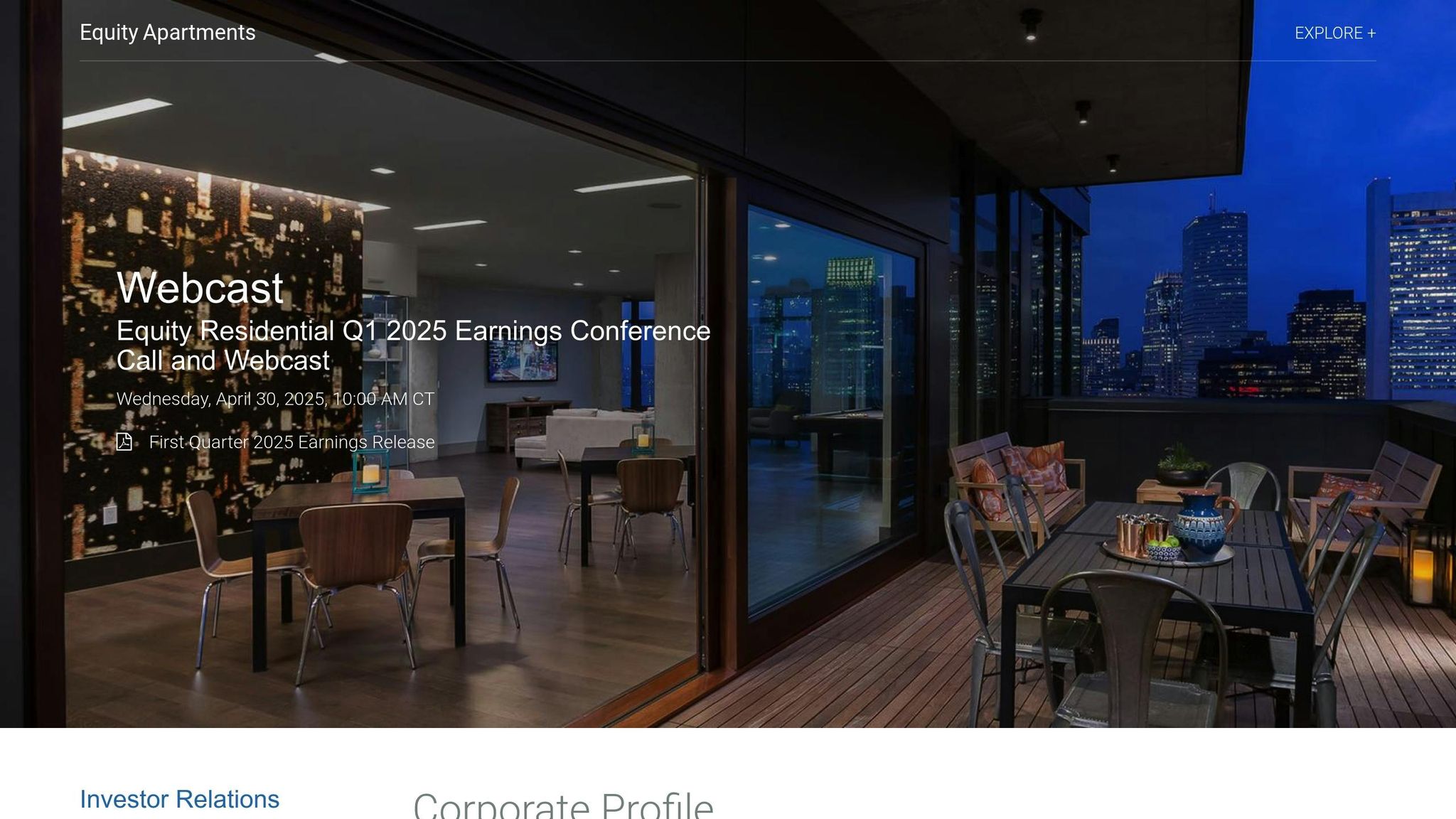
Equity Residential stands as one of the largest apartment owners in the United States, managing an impressive portfolio of 312 properties and 84,648 apartment units as of March 31, 2025 [25]. As a publicly traded Real Estate Investment Trust (REIT) and a member of the S&P 500, the company has firmly established itself in major markets like Boston, New York, Washington, D.C., Seattle, San Francisco, and Southern California. Recently, it has also expanded into growing markets such as Denver, Atlanta, Dallas/Ft. Worth, and Austin [25]. This strategic mix of established coastal hubs and emerging regions highlights the company’s adaptability in managing a large-scale portfolio.
Ownership Structure
Equity Residential’s investor base reflects a broad mix of stakeholders:
| Investor Category | Ownership Percentage | Description |
|---|---|---|
| Institutional Investors | 88% | Includes mutual funds, pension funds, ETFs |
| Retail Investors | 11% | Individual shareholders |
| Company Insiders | 1% | Executives and board members |
This diverse ownership structure strengthens the company’s market position and stability.
Performance and Revenue
In 2024, the company maintained an impressive average physical occupancy rate of 96% and achieved a blended rent growth of 2–3%. These factors contributed to a total revenue of approximately $2.88 billion [27]. Residential rentals remain the backbone of its income, accounting for around 96% of total revenue, while ancillary services like parking, storage, and pet fees make up the remaining 4%:
| Revenue Source | Percentage | Details |
|---|---|---|
| Residential Rentals | ~96% | Primary income source |
| Ancillary Services | ~4% | Includes services like parking |
Recent Developments and Financial Health
In August 2024, Equity Residential expanded its portfolio by acquiring 11 additional properties. The company’s financial stability is reflected in its conservative debt-to-equity ratio of 0.63, which positions it well for future growth [26][28].
To keep up with industry trends, Equity Residential utilizes online leasing platforms, resident portals, and data analytics to streamline operations and enhance efficiency [27]. This tech-forward approach ensures the company remains competitive in an evolving market.
6. AvalonBay Communities
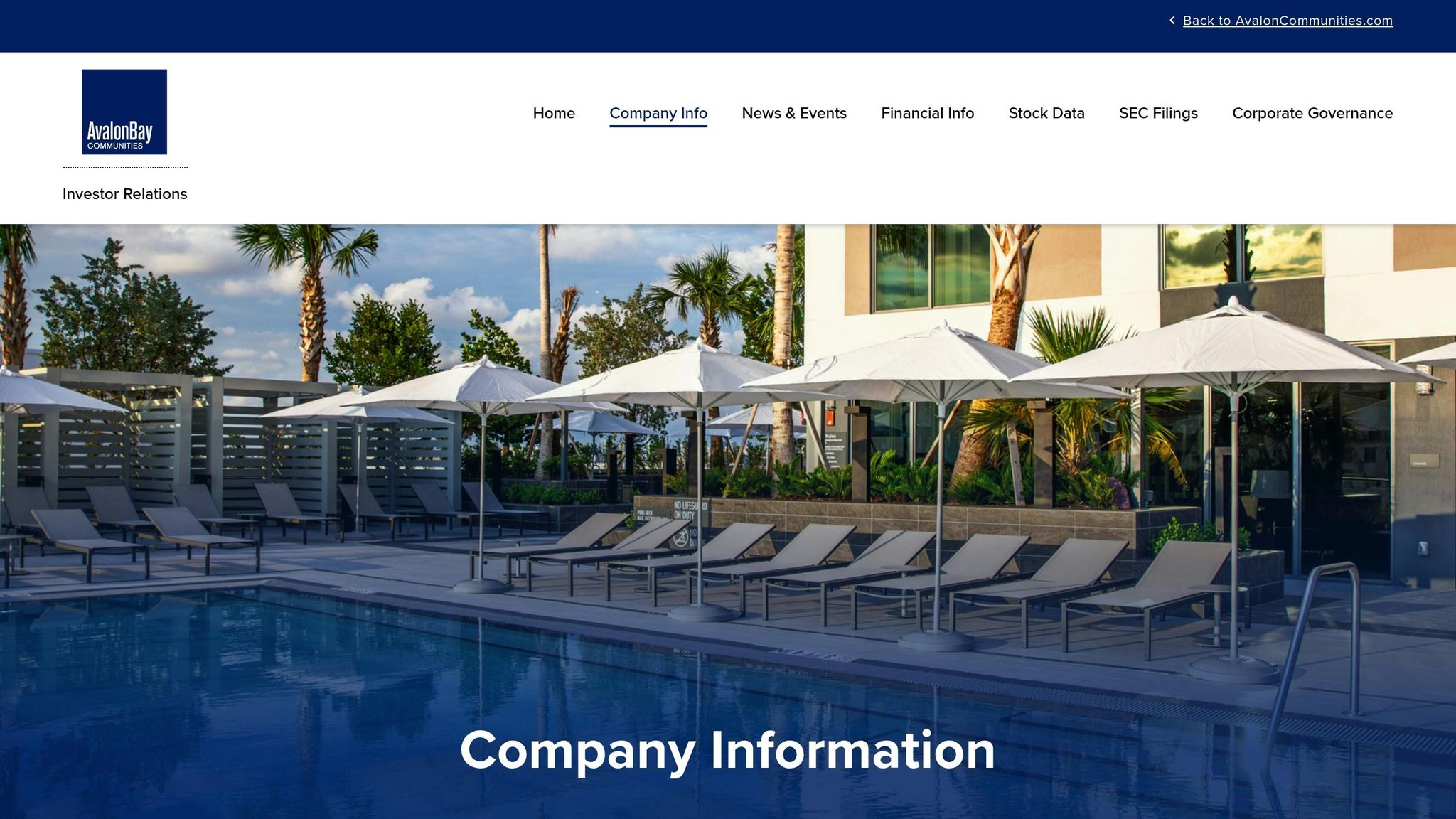
AvalonBay Communities stands out as a major equity REIT, managing 309 apartment communities and overseeing 94,865 homes across 11 states and the District of Columbia [30].
Portfolio Distribution and Strategy
AvalonBay's portfolio is strategically concentrated in coastal regions and areas with high growth potential:
| Region | Portfolio Percentage | Key Markets |
|---|---|---|
| East Coast | 47% | New York/New Jersey, Mid-Atlantic |
| West Coast | 41% | Northern California, Southern California, Pacific Northwest |
| Expansion Markets | 12% | Dallas, Austin, Denver, Southeast Florida |
The company plans to shift its focus further by increasing its suburban holdings from 73% to 80% and expanding its presence in growth markets from 12% to 25% [29].
Operational Performance
AvalonBay's operational results underscore its strategic execution:
| Metric | Q4 2023 Performance |
|---|---|
| Average Monthly Rent | $2,533 |
| Occupancy Rate | 95.7% |
| Total Real Estate Assets | $24.6 billion |
Development and Growth
AvalonBay is actively expanding through new developments:
- 19 communities currently under development [30]
- Delivered 1,993 apartment homes in 2023, with a total development cost of $815 million [32]
- A pipeline of 5,000 apartment homes, representing a $2.1 billion investment [32]
Operational Innovation
AvalonBay has embraced an innovative operational model by leveraging regional service centers for efficiency.
"Our remote support makes the neighborhood model viable" - Michael Coyne, AVB's vice president of operations [31]
In September 2024, the company opened its second service center in San Antonio, Texas, complementing its existing Virginia Beach facility. The San Antonio center is expected to employ 50 associates by the end of 2024 [31].
Market Focus
AvalonBay prioritizes markets with specific characteristics:
- Strong growth in high-wage employment sectors
- Limited housing affordability
- A vibrant and diverse quality of life
- Robust rental household formation rates [33][34]
This calculated approach not only positions AvalonBay as a market leader but also highlights how large portfolios influence vendor management practices, a topic explored further in the next section.
7. Cortland
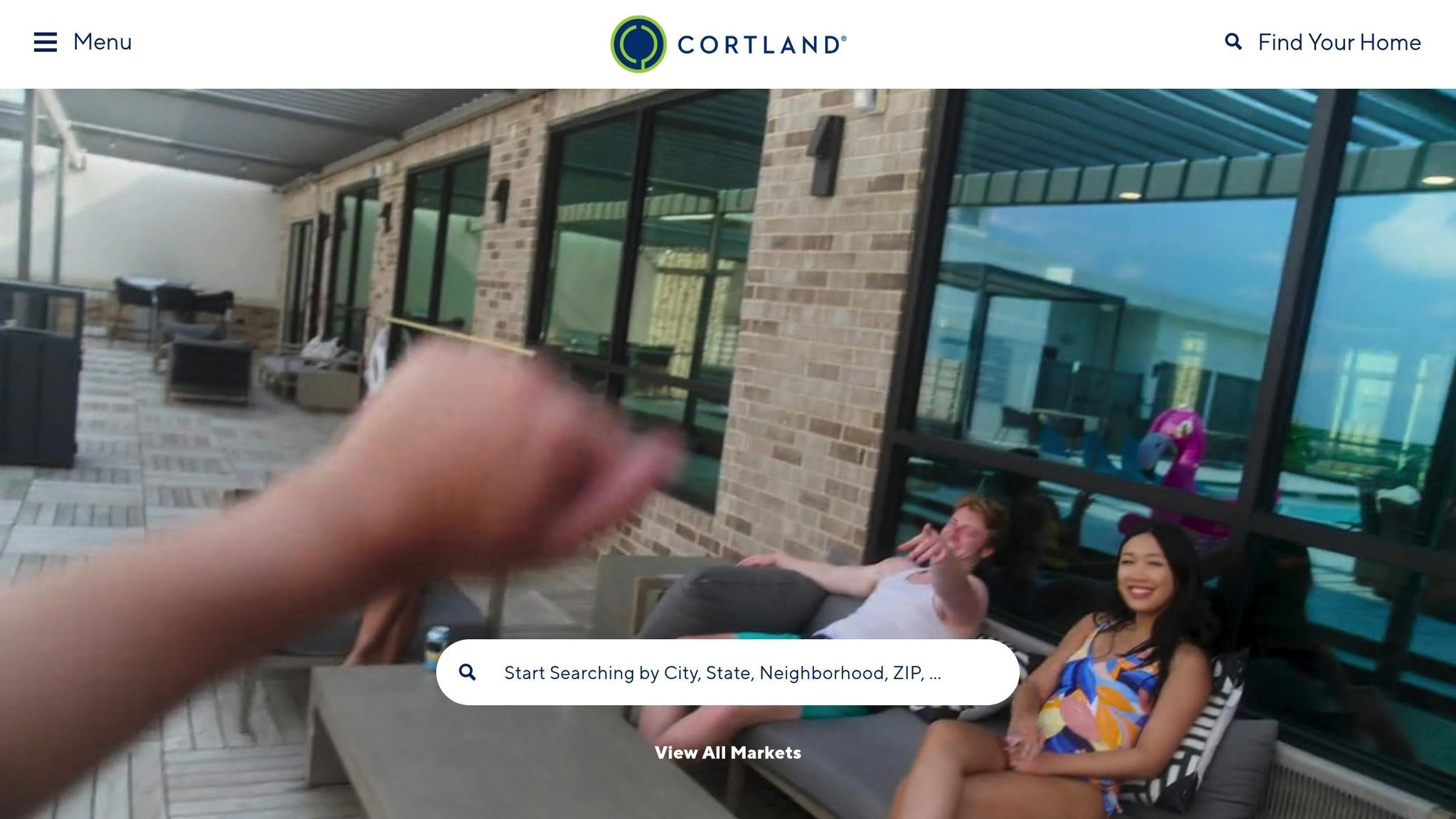
Cortland oversees 244 assets with a total value of $20.3 billion as of January 2025 [35]. Their portfolio spans 78,119 units in 26 U.S. markets, with a strong presence in regions like the Sun Belt and Mountain West [35][38].
Portfolio Structure and Management
Cortland's portfolio is carefully divided into two main categories:
| Category | Details | Percentage |
|---|---|---|
| Client Funds & Managed Vehicles | 156 Real Estate Assets | 66.5% |
| Direct Ownership | 88 Properties | 33.5% |
| Total Portfolio Value | $20.3 billion | 100% |
This structured approach supports their integrated operational strategy, ensuring efficiency and clarity in asset management.
Operational Model
Cortland operates with a vertically integrated model, combining investment, design, construction, operations, renovations, and asset management under one roof. This all-encompassing approach allows them to achieve notable cost savings, with in-house manufacturing cutting expenses by 30–40% compared to typical bulk providers in the U.S. [41].
Strategic Market Presence
Cortland has established regional offices in several key locations, including:
- Charlotte
- Dallas
- Denver
- Greenwich
- Houston
- Orlando
- Phoenix [36]
These offices strengthen their foothold in important markets, enabling them to deliver consistent services while leveraging technology to enhance resident experiences.
"Cortland is the extreme of 'an inch wide and mile deep' in terms of our focus on market-rate apartment buildings that we acquire, renovate, manage and then eventually dispose of. We do one thing and do it extremely well with a degree of focus and attention that you rarely find in the real estate investment management world."
– Jason Kern, Cortland's President of Investment Management [39]
Innovation in Property Management
In 2017, Cortland took a forward-thinking step by installing 12,000 Nest Learning Thermostats across its properties, embracing smart home technology [40]. This move not only enhances resident satisfaction but also streamlines vendor relationships, aligning with their broader strategic goals.
The company’s resident-first approach is supported by a team of 2,283 associates [35], who focus on delivering hospitality-inspired services. Their efforts include integrating smart home features, executing extensive property renovations, and incorporating localized luxury design elements to elevate the living experience.
"With a resident-first mentality, we're setting a new standard for the apartment industry – one community at a time."
– Cortland [37]
8. Asset Living
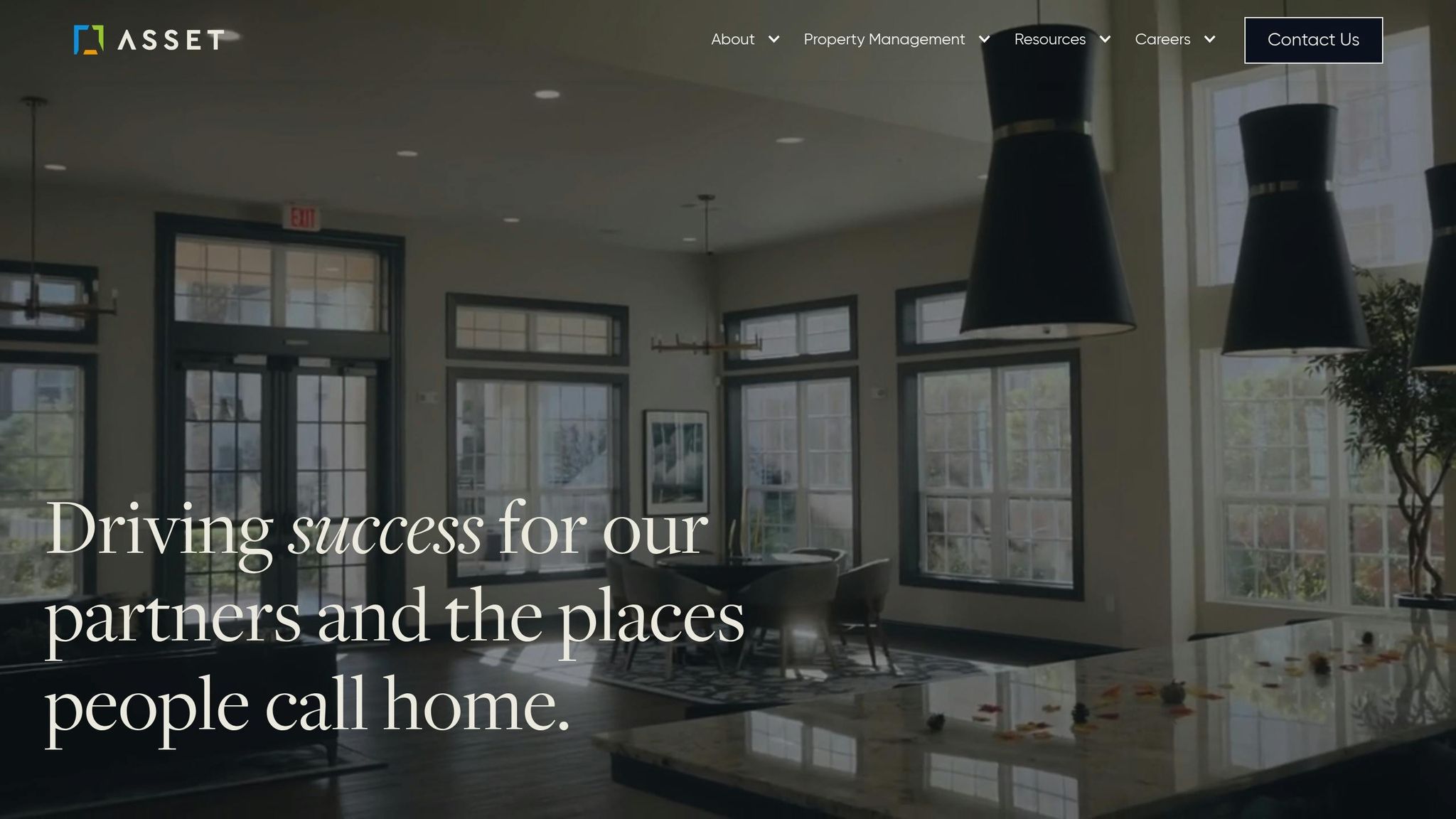
Asset Living ranks as the second-largest apartment manager in the United States, overseeing 288,665 units with a portfolio valued at $55 billion [42][43]. The company’s integrated management strategy reflects the changing landscape of large-scale apartment management across the country.
Portfolio Composition and Market Presence
Operating in more than 40 states [47], Asset Living offers a wide range of management services tailored to diverse property types:
| Property Type | Management Focus |
|---|---|
| Multi-family Communities | Comprehensive management services |
| Student Housing | #1 third-party manager for 13 consecutive years [44] |
| Affordable Housing | Third-largest manager in the nation [44] |
| Active Adult Communities | Specialized services for senior living |
| Build-to-Rent Properties | Early leader in this emerging market [45] |
In addition to property management, the company provides expertise in asset management, investment services, and receivership solutions [44].
Management Excellence and Performance
Asset Living is recognized as an Accredited Management Organization (AMO) [44], a distinction that highlights its commitment to quality. The company boasts a 65% resident retention rate across its communities [46] and has housed over 5 million residents since its founding in 1986 [46]. These achievements underscore its dedication to operational excellence and resident satisfaction.
Innovation and Future Focus
Asset Living continues to push boundaries in property management, particularly in the build-to-rent space. Their forward-thinking approach combines community-focused living, advanced technology, and sustainability:
"We see the future of build-to-rent as a blueprint for housing innovation, where community-centric living, technology, and sustainability converge to meet the evolving needs of the rental generation." [45]
Their use of data-driven market analysis has solidified their position as an industry leader. Reflecting on the company’s success, their CEO shared:
"The unwavering faith our partners place in us fuels our relentless pursuit of progress. To those entrusting us with their communities and residents, we extend our heartfelt gratitude." [47]
9. Willow Bridge Property Company
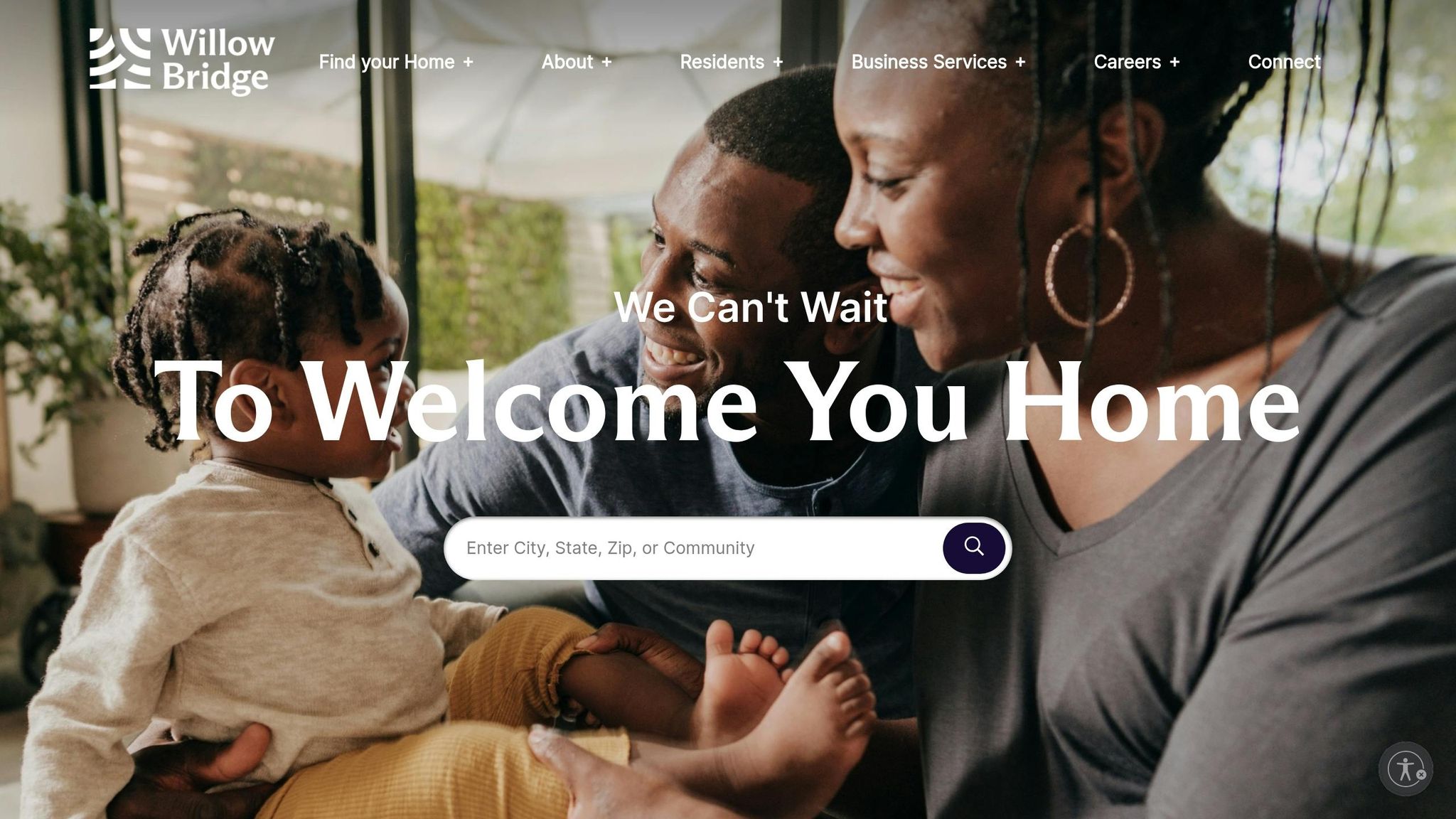
Willow Bridge Property Company holds the position of the third-largest multifamily manager in the United States, overseeing an impressive 220,676 units across 75 markets in 27 states and the District of Columbia [48][49].
Portfolio and Market Presence
Here's a snapshot of Willow Bridge's operations:
| Category | Metrics |
|---|---|
| Units Under Management | 220,676 units [49] |
| Geographic Presence | 75 markets across 27 states + D.C. [48] |
| Owned Assets (AUM) | $3 billion [48] |
| Development Portfolio | Over 200,000 units developed [48] |
| Workforce | 5,200+ team members [49] |
| Renovation Oversight | $3+ billion in renovations [48] |
The company has recently expanded its portfolio, showcasing strategic growth and solidifying its foothold in the market [52]. This extensive reach supports Willow Bridge's streamlined operations, which combine property management and development expertise.
Business Model and Operations
Willow Bridge operates through a vertically integrated platform that merges property management with development capabilities. In 2023, the company was recognized as one of the 25 Largest Developers, initiating 2,854 units that year [52]. Additionally, in April 2025, Blue Ridge Companies transferred over 10,000 units across 35 properties to Willow Bridge, further boosting its portfolio [51].
"Although our raw numbers suggest a dip, our net unit growth - from 180,000 to over 200,000 in 2023 - demonstrates our strong market position and the robust partnerships driving our success."
- Scott Wilder, President, Residential Management for Willow Bridge [52]
Investment and Development Strategy
Willow Bridge's growth is fueled by a solid investment strategy that complements its operational model. The MQMF Fund, in partnership with the Ontario Teachers' Pension Plan and Investment Management Corporation of Ontario, manages a $3 billion portfolio spread across 13 communities. On top of that, an additional $1 billion in developments is currently in progress [50]. This integrated approach helps standardize services and vendor selection across the company's vast portfolio.
"This recognition is a testament to the dedication and expertise of our teams. As a purpose-driven organization, our focus remains on sustainable growth and providing the highest level of service to our clients and residents who choose to call a Willow Bridge community home."
- Duncan Osborne, CEO of Willow Bridge [49]
10. RPM Living
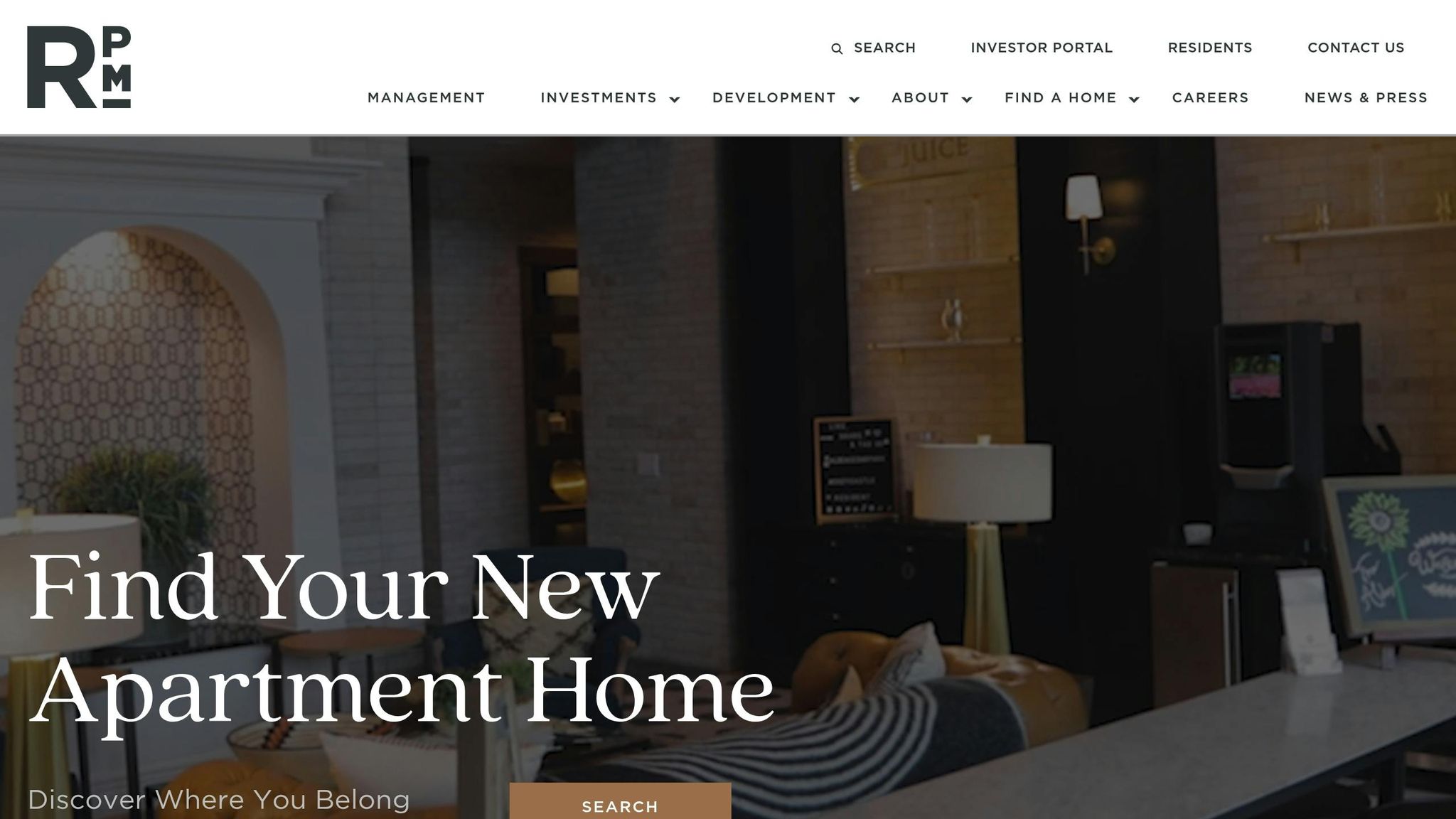
RPM Living has seen remarkable growth in recent years, establishing itself as one of the largest multifamily property management companies in the United States. With a focus on scaling operations and building strategic vendor partnerships, the company currently oversees 226,169 units across 26 states. This achievement has earned RPM Living the position of third-largest apartment manager on the NMHC Top 50 list [59].
Portfolio Growth and Market Position
RPM Living's rise in the NMHC rankings illustrates its steady expansion:
| Year | NMHC Ranking | Growth |
|---|---|---|
| 2020 | #42 | Initial ranking |
| 2023 | #6 | +110,000 units |
| 2024 | #3 | +78,169 units |
In 2023 alone, the company added 75,000 units, representing a portfolio growth rate of 52.2% from the previous year [53][59]. This rapid expansion highlights RPM Living's strong operational foundation and ability to scale effectively.
Business Structure and Operations
RPM Living operates as a vertically integrated multifamily management and investment firm, formed in March 2021 through the merger of F&B Capital, Roscoe Properties, and CF Real Estate Services [54]. Its structure includes:
- Operations in 26 states
- A team of over 4,600 professionals
- An owned portfolio valued at $3 billion [55][57]
"What drives our company is a constant focus on best practice, business objectives and our team members; making sure we're never complacent and not doing things just because it's how they've always been done."
– Jason Berkowitz, CEO [55]
This integrated approach and commitment to innovation enable RPM Living to execute an ambitious growth strategy.
Investment and Development Strategy
RPM Living's investment strategy is built around identifying value-add opportunities, leveraging market insights, and pursuing targeted development projects. Recent enhancements in predictive analytics and forecasting have strengthened their approach [60]. The company’s development division has completed over 1,500 units, with an additional 1,550 units currently under construction. Together, these projects total more than 1,609,000 gross square feet. Additionally, RPM Living is managing $431 million in active development and construction deals [56][58].
"As we expand our footprint across the United States, our mission remains the same: to foster people-centric work environments where associates thrive, and create living experiences residents recommend to others, while creating exceptional performance that nurtures longstanding client partnerships."
– Jason Berkowitz, Chief Executive Officer of RPM Living [53]
11. Security Capital Pacific
Security Capital Pacific has evolved from being an early trailblazer in the real estate sector to becoming a prominent market leader. Back in 1996, through its affiliate SCG Realty Services, the company earned the 9th spot among the Top 10 apartment owners - an exclusive group for firms managing more than 50,000 units [61]. At that time, the top 50 apartment owners together controlled less than 12% of all rental apartments in the U.S. [61]. This legacy laid the groundwork for its current, research-focused approach.
Today, Security Capital operates through Security Capital Research & Management Incorporated, a registered investment adviser since 1995. This division uses tools like market trend analysis, cash flow evaluation, and equity pricing to enhance portfolio performance [62].
With a leadership team boasting an average of 28 years of experience in the industry, Security Capital now manages over $5 billion in assets, supervises more than 30,000 units, and oversees property values exceeding $6 billion [63].
"Our diverse portfolio of performing assets and our senior management team with an average of 28 years industry experience provide an uncommon level of multifamily expertise. That focus on multifamily housing has allowed our management team to develop outstanding skills, insights, and relationships over multiple real estate cycles." - Security Properties [63]
Adding to its accomplishments, the company has launched six funds that have invested in over 20,000 units with a total cost basis of more than $4.5 billion. Under the leadership of David Wartena, their construction division has renovated over 25,000 units, managing capital projects worth upwards of $500 million since 2013 [63].
12. BH Management Services

BH Management Services has set a high standard in large-scale portfolio management, blending integrated operations with cutting-edge technology to improve efficiency. Headquartered in Des Moines, Iowa, BH is a prominent multifamily owner-operator that manages over 210,000 homes across multifamily, student housing, and build-to-rent sectors [66]. The company’s acquisition by Pretium in May 2024 has bolstered its market standing while allowing it to maintain operational independence.
Before joining Pretium, BH oversaw 114,000 multifamily units spread across 450+ communities in 28 states. It also managed 9,000 student housing units and 1,500 build-to-rent homes [64][69].
What sets BH apart is its commitment to vertical integration and a data-driven approach. Tools like BH Fusion®, its proprietary advertising platform Aylist, and the centralized 'Mint Experience' management system are at the core of its operations [68][65].
"At BH, we've always dared to be different, and we think there's a smarter way to meet residents' expectations. Thank you to PropTech Breakthrough for recognizing our continuing efforts."
– Joanna Zabriskie, President & CEO of BH [65]
BH has significantly improved its operational processes, including boosting call handling efficiency by over 88% and managing lease renewals for more than 220 communities [65][67]. In 2022, the company introduced a network inventory management system that cut telecom costs by over 25% while improving property operations.
"The addition of BH enhances Pretium's residential ecosystem, enabling us to deploy capital across all major residential asset classes in both debt and equity. This transaction creates additional opportunities for our investors and will drive more investment in residential real estate, contributing to a healthier housing economy and increased housing options for families across the country."
– Jonathan Pruzan, Pretium President [66]
With a workforce of 7,200 employees serving nearly 700,000 residents and homeowners annually [66], BH emphasizes cost control, centralization, and prioritizing people in its operations. Its dedication to ESG principles and technological advancements ensures the company remains on a strong growth trajectory. By refining its strategies, BH continues to influence vendor standards and operational practices across its expansive portfolio.
How Large Portfolios Impact Vendor Management
When it comes to vendor management, large portfolio operators use their scale to influence industry practices [1]. Their approach to selecting and managing vendors not only meets their growing procurement needs - which are increasing by 10.6% annually [71] - but also sets trends across the multifamily sector.
By centralizing vendor management, these operators create consistency and improve efficiency. This standardization allows them to negotiate better pricing and ensure reliable service delivery.
"Rents, occupancy, income growth projections, expenses and turn times should be in-line with or favorable to similar vintage properties within a given submarket... We also look at scale in a market, in-place talent, teammate retention, vendor partnerships and pricing."
- Zamir Kazi, CEO, ZMR Capital [70]
Vendor Selection Criteria
For large portfolio owners, choosing the right vendors involves evaluating several key factors:
| Criteria | Role in Decision-Making |
|---|---|
| Cost | Takes advantage of volume discounts and competitive pricing |
| Quality and Reliability | Ensures steady performance and reduces operational hiccups |
| Experience and Reputation | Builds trust through proven results and tenant satisfaction |
| Service | Focuses on timely responses and meeting commitments |
This emphasis on cost, quality, and service has led many operators to adopt advanced technologies and implement strict performance monitoring systems.
Technology and Automation
Technology plays a pivotal role in modern vendor management. In fact, 64% of finance leaders prefer payment automation to simplify supplier management [72]. Centralized platforms make it easier to manage supplier data and streamline communication across properties.
"With Ivalua we finally have 360 degree visibility of suppliers and contracts and automate the full source-to-pay process in a system our users enjoy using."
- Cyrille Chouvet, Supplier Quality & Purchasing Process Manager, Verallia Group [71]
Performance Monitoring
To maintain consistency and control costs, many operators rely on centralized systems and key performance indicators (KPIs). These tools help ensure vendors deliver the expected level of service. As Marc DeLuca points out:
"KPIs are among the data we analyze, and they are clearly important... We also assemble our own proprietary data. Management teams are required to match their level of service to the quality of the property they are managing."
- Marc DeLuca, CEO, Eastern Regional President, KBS [70]
Even with the advantages of centralized systems, local market dynamics still play a crucial role in shaping vendor relationships.
Local Market Considerations
While standardization brings efficiency, successful portfolio managers also recognize the importance of local market nuances. As Anthony Rossi Sr. explains:
"Every building we manage has its own unique personality, often shaped by the surrounding community... Our team enjoys infusing that local flavor into the activities we plan to engage residents, often tapping a popular local restaurant, bakery or shop to partner with for a resident gathering."
- Anthony Rossi Sr., Chairman, RMK Management Corp [70]
With 77% of businesses incorporating supplier collaboration into their strategies [72], building structured vendor relationships remains essential for balancing service quality with operational efficiency.
Changes in Multifamily Property Management
The multifamily property management industry is seeing a wave of transformation in 2025, fueled by advancements in technology, evolving market conditions, and shifting resident needs [73]. These changes are reshaping how properties are managed, influencing vendor relationships, and driving a new standard in operations.
Market Stabilization and Growth
After the record-breaking addition of 692,000 new units in 2024 - the most in 40 years - the market is beginning to stabilize [73]. Construction activity has slowed, with starts down 74% from their 2021 peak [76]. Developers are now aiming to introduce 410,000 new units in 2025 [77]. This stabilization is creating an environment ripe for technology adoption in property management.
"We're finally seeing more normalcy in the market, and we're clawing our way back after a 75% decrease in investment sales transactions activity in 2023. Real estate valuations have nearly reached the bottom."
- Stephanie Wiggins, head of agency and Federal Housing Administration production at PGIM Real Estate [77]
Technology-Driven Operations
Technology continues to play a transformative role in the industry, enhancing both efficiency and resident satisfaction. Here’s how various innovations are making an impact:
| Technology Impact | Results |
|---|---|
| AI Leasing Tools | 70% of owners report higher conversion rates [73] |
| Smart Building Systems | Maintenance costs reduced by 25% [73] |
| Smart Home Features | 78% of renters are drawn to these amenities [73] |
| IoT Solutions | Energy costs cut by 15–30% [79] |
Portfolio Diversification Trends
Third-party management companies are proactively expanding their portfolios, focusing on strategic growth:
- 91% plan to grow their portfolios [74]
- 31% are diversifying into different property types [74]
- 23% are targeting new geographic markets [74]
Sustainability and Resident Preferences
Sustainability is becoming a key factor in attracting renters. Properties that incorporate eco-friendly features and smart technologies are experiencing a 10% increase in rental demand [78]. This mirrors the growing expectations of residents who value environmental responsibility alongside technological convenience. At the same time, these efforts help streamline operations and lower costs.
"Favorable long-term demographics support sustained multifamily demand - particularly as high home prices keep younger generations in the rental market."
- Laura Khouri, president and chief operating officer of Western National Property Management [77]
Operational Efficiency
Technology has turned operational efficiency into a competitive edge. For example, some companies have scaled their capital under management from $50 million to $400 million in just four years by leveraging advanced tools [76].
Market Outlook
The multifamily sector is poised for growth in 2025, with several positive indicators:
- Vacancy rates are projected to improve to 4.9% by the end of the year [76].
- The cost gap between renting and owning has widened to 25%, the largest in 15 years [76].
- Declining interest rates are contributing to cap rate compression [75].
"We're bracing for a busy 2025. We're focused on recruiting and retaining talent so that we're best prepared to capitalize on these opportunities."
- Stephanie Wiggins, head of agency and Federal Housing Administration production at PGIM Real Estate [77]
These trends are shaping a more advanced, technology-driven property management landscape. With their resources and scale, larger portfolio owners are particularly well-positioned to thrive in this evolving environment, where operational efficiency and resident satisfaction take center stage.
Conclusion
The U.S. apartment market is heavily influenced by a concentrated group of players, with NMHC owners and managers holding a large portion of the nation's apartment units. Metrics from NMHC highlight this concentration, shaping the standards and practices across the industry [1].
At the forefront is Greystar, managing a staggering 946,742 units and owning 122,545 units [2]. This combination of ownership and management reflects a growing trend toward integrated models that aim to streamline operations and improve efficiency.
Ownership and management roles, while distinct, reveal key market dynamics:
| Category | Market Share | Leading Company | Unit Count |
|---|---|---|---|
| Top Owners | 11% | Greystar | 122,545 |
| Top Managers | 21% | Greystar | 946,742 |
These figures highlight the forces driving the industry's structure and evolution.
"Successful family businesses often view ownership as a stewardship role, where owners are caretakers of the business's values and legacy." – Harvard Business Review [82][83]
Several trends are shaping the future of the multifamily market:
- Technology Integration: Automated tools are becoming a staple for property managers, improving efficiency and streamlining operations [80].
- Market Expansion: A 19.6% surge in rent growth since 2020 has drawn increased institutional investment [80].
- Professional Management: While smaller multifamily properties (45%) are often self-managed, larger portfolios typically rely on professional management companies to tap into specialized expertise [81].
This interconnected structure of ownership and management not only enhances operational standards but also influences vendor relationships and fosters innovation. As the market matures, the clear division between these roles becomes even more critical for ensuring effective governance and supporting long-term growth in the multifamily sector.
FAQs
How do large apartment management companies benefit from centralizing their operations?
Centralizing operations offers large apartment management companies a practical way to boost efficiency and cut costs. By bringing tasks like leasing, maintenance, and tenant communication into one unified system, companies can simplify workflows, eliminate redundancies, and automate repetitive tasks. The result? Faster service delivery, smarter decision-making, and reduced operational expenses.
It also strengthens vendor management and negotiation, enabling companies to secure better deals and create consistent processes across all their properties. These streamlined operations not only enhance tenant satisfaction but also positively impact financial performance, making centralization a smart approach for managing extensive property portfolios.
How does technology shape the management of large apartment portfolios and improve tenant experiences?
How Technology is Changing Apartment Portfolio Management
Technology is reshaping the way large apartment portfolios are managed, making operations smoother and improving tenant experiences. Tools like smart thermostats and automated maintenance systems are cutting costs while giving tenants more convenience and control. For instance, smart thermostats can slash energy bills by up to 20%, benefiting both tenants and property managers.
On top of that, AI and data analytics are stepping in to make a big difference. They enable predictive maintenance and automated communication, which means faster fixes for issues and more seamless daily operations. These advancements create a more connected and responsive environment for tenants, boosting satisfaction and encouraging long-term loyalty. By adopting these technologies, property managers can better meet the rising expectations of today’s renters while keeping their portfolios running efficiently.
Why are top apartment companies like Greystar combining ownership and management?
Why Are Top Apartment Companies Combining Ownership and Management?
Leading apartment companies, like Greystar, are increasingly embracing vertical integration, where they both own and manage their properties. Why? Because this approach brings a host of strategic advantages.
By keeping management in-house, these companies can simplify operations, maintain consistent service standards, and provide a better experience for tenants. It also allows them to cut costs, address tenant concerns faster, and stay ahead of shifting market trends.
Take Greystar as an example. Their success speaks volumes, with a vast portfolio and recognition across the industry. This model has clearly played a key role in their rise as a leader in the competitive world of multifamily housing.